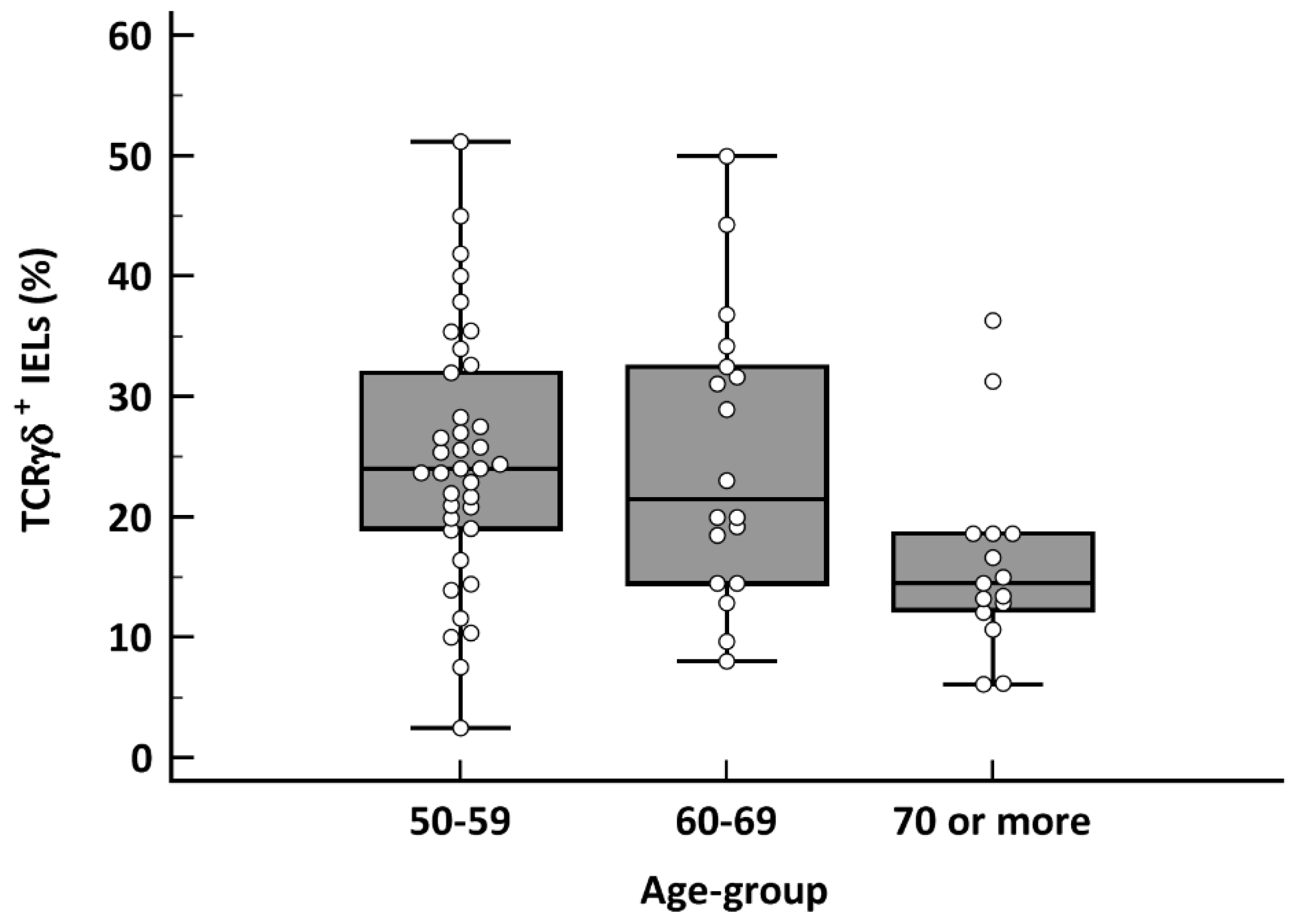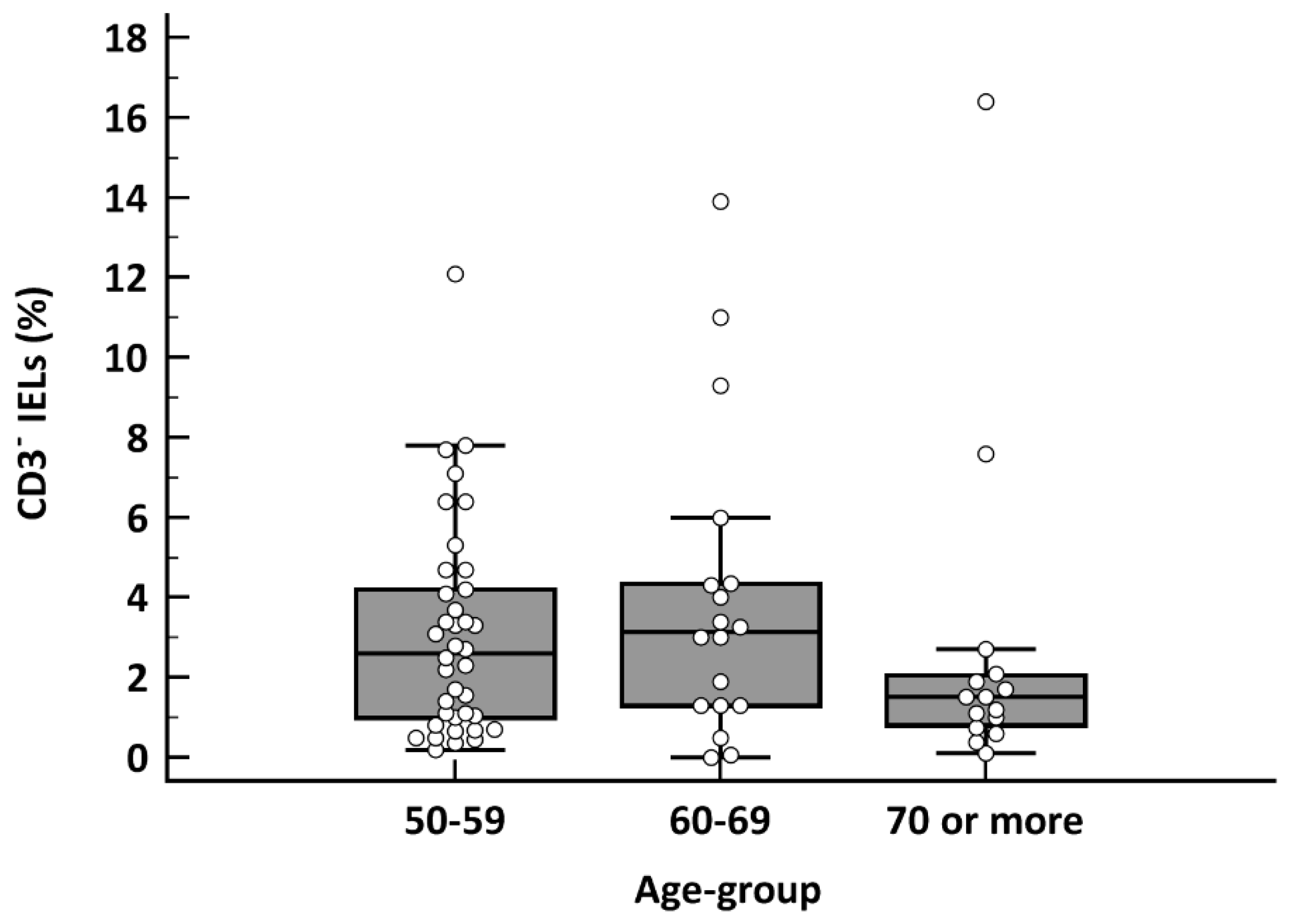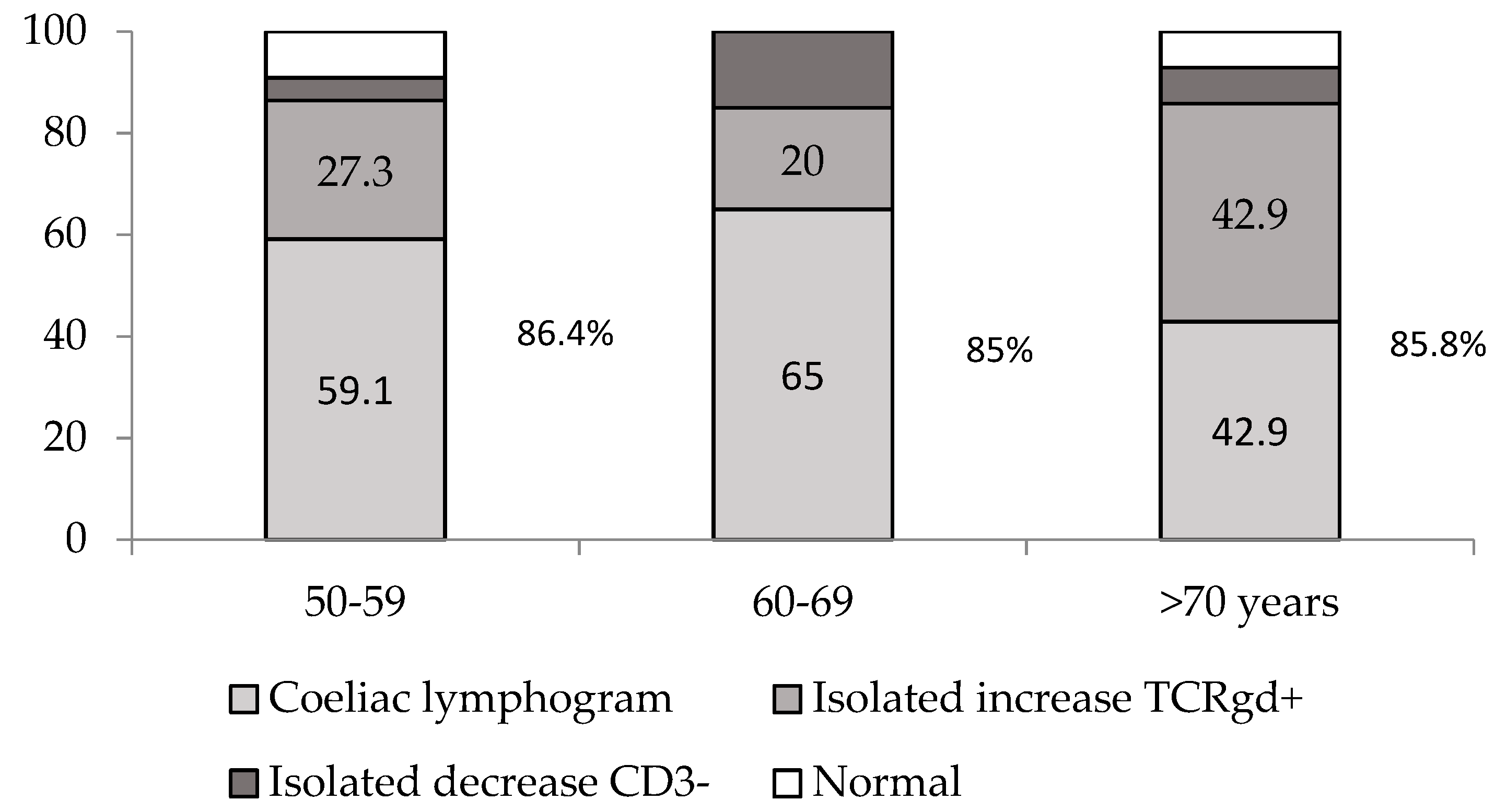Coeliac Disease in Elderly Patients: Value of Coeliac Lymphogram for Diagnosis
Abstract
:1. Introduction
2. Materials and Methods
2.1. Study Design
2.2. Ethical Issues
2.3. Flow Cytometry Analysis
2.4. Coeliac Serology
2.5. Histological Studies
2.6. Statistical Analysis
3. Results
3.1. Patients
3.2. Clinical Phenotype
3.3. Flow Cytometry Pattern at Diagnosis
3.4. Flow Cytometry Pattern at Follow-Up
4. Discussion
5. Conclusions
Supplementary Materials
Author Contributions
Funding
Institutional Review Board Statement
Informed Consent Statement
Data Availability Statement
Acknowledgments
Conflicts of Interest
Appendix A. Concordance in Intraepithelial Lymphocyte Analysis between Different Cytometres and Centres
| Subject | BD FACSCalibur CATLAB | BD FACSCanto CATLAB | BD FACSCanto Hospital Ramón y Cajal | |||
|---|---|---|---|---|---|---|
| TCRγδ+ | CD3− | TCRγδ+ | CD3− | TCRγδ+ | CD3− | |
| 1 | 0.94 | 15.88 | 1.4 | 15.3 | 1 | 16.8 |
| 2 | 5.72 | 2.52 | 4.3 | 4.1 | 5.5 | 4.3 |
| 3 | 35.57 | 5.03 | 32.1 | 6.2 | 40 | 6.3 |
| 4 | 35.77 | 6.2 | 33.1 | 6.1 | 36.8 | 3.4 |
| 5 | 4.05 | 4.75 | 4.3 | 5.2 | 6.1 | 5.5 |
| 6 | 17.34 | 9.64 | 14.6 | 10 | 24.6 | 8.7 |
| 7 | 12.59 | 0.98 | 12.6 | 1.08 | 16.9 | 0.7 |
| 8 | 1.17 | 40.44 | 1.2 | 40.4 | 1.2 | 49.5 |
| 9 | 5.27 | 17.7 | 5.2 | 17.5 | 8.2 | 26.6 |
| 10 | 5.86 | 23.03 | 5.8 | 24.6 | 6.8 | 31.4 |
| 11 | 6.54 | 11.72 | 7 | 11.2 | 9.3 | 13.3 |
| 12 | 35.67 | 4.49 | 35.5 | 6.7 | 38.8 | 5.4 |
| 13 | 1.92 | 33.45 | 1.3 | 32.5 | 7.5 | 31.4 |
| 14 | 16.94 | 7.4 | 16.5 | 8.1 | 27.5 | 0.7 |
| 15 | 16.33 | 2.45 | 16.3 | 2.2 | 28.7 | 1.5 |
| CD3− | TCRγδ+ | |||
|---|---|---|---|---|
| Variable X | Variable Y | Variable X | Variable Y | |
| Passing and Bablok regression | ||||
| Lowest value | 1.08 | 0.98 | 1.2 | 0.94 |
| Highest value | 40.4 | 40.44 | 35.5 | 35.77 |
| Arithmetic mean | 12.74 | 12.37 | 12.74 | 13.445 |
| Median | 8.1 | 7.4 | 7 | 6.54 |
| SD | 11.52 | 11.82 | 11.98 | 12.75 |
| SE of the mean | 2.9751 | 3.0523 | 3.0943 | 3.2937 |
| Regression Equation | y = −0.617424 + 1.032197x | y = −0.145981 + 1.035514x | ||
| Systematic differences | ||||
| Intercept A | −0.6174 | −0.146 | ||
| 95% CI | −1.5254 to −0.07676 | −0.6255 to 0.08486 | ||
| Proportional differences | ||||
| Slope B | 1.0322 | 1.0355 | ||
| 95% CI | 0.9785 to 1.1019 | 0.9971 to 1.1182 | ||
| Random differences | ||||
| RSD | 0.6455 | 0.8313 | ||
| ±1.96 RSD Interval | −1.2652 to 1.2652 | −1.6293 to 1.6293 | ||
| Linear model validity | ||||
| Cusum test for linearity | p = 0.92 | p = 0.99 | ||
| Spearman rank correlation coefficient | ||||
| Correlation coefficient | 0.975 | 0.969 | ||
| Significance level | p < 0.0001 | p < 0.0001 | ||
| 95% CI | 0.924 to 0.992 | 0.906 to 0.990 | ||
| CD3− | TCRγδ+ | |||
|---|---|---|---|---|
| Variable X | Variable Y | Variable X | Variable Y | |
| Passing and Bablok regression | ||||
| Lowest value | 0.7 | 0.98 | 1 | 0.94 |
| Highest value | 49.5 | 40.44 | 40 | 35.77 |
| Arithmetic mean | 13.7 | 12.37 | 17.26 | 13.44 |
| Median | 6.3 | 7.4 | 9.3 | 6.54 |
| SD | 14.59 | 11.82 | 14.11 | 12.75 |
| SE of the mean | 3.768 | 3.0523 | 3.6436 | 3.2937 |
| Regression Equation | y = 1.271610 + 0.785593x | y = −0.805921 + 0.796053x | ||
| Systematic differences | ||||
| Intercept A | 1.2716 | −0.8059 | ||
| 95% CI | −0.9053 to 3.4190 | −2.6434 to 0.9249 | ||
| Proportional differences | ||||
| Slope B | 0.7856 | 0.7961 | ||
| 95% CI | 0.6241 to 0.9991 | 0.6038 to 0.9875 | ||
| Random differences | ||||
| RSD | 2.5237 | 2.8749 | ||
| ±1.96 RSD Interval | −4.9465 to 4.9465 | −5.6348 to 5.6348 | ||
| Linear model validity | ||||
| Cusum test for linearity | p = 0.69 | p = 0.49 | ||
| Spearman rank correlation coefficient | ||||
| Correlation coefficient | 0.877 | 0.925 | ||
| Significance level | p < 0.0001 | p < 0.0001 | ||
| 95% CI | 0.661 to 0.958 | 0.784 to 0.975 | ||
| CD3− | TCRγδ+ | |||
|---|---|---|---|---|
| Variable X | Variable Y | Variable X | Variable Y | |
| Passing and Bablok regression | ||||
| Lowest value | 0.7 | 1.08 | 1 | 1,2 |
| Highest value | 49.5 | 40.4 | 40 | 35.5 |
| Arithmetic mean | 13.7 | 12.74 | 17.26 | 12.74 |
| Median | 6.3 | 8.1 | 9.3 | 7 |
| SD | 14.5935 | 11.5223 | 14.1115 | 11.9843 |
| SE of the mean | 3.768 | 2.9751 | 3.6436 | 3.0943 |
| Regression Equation | y = 1.212500 + 0.791667x | y = −0.107611 + 0.764259x | ||
| Systematic differences | ||||
| Intercept A | 1.2125 | −0.1076 | ||
| 95% CI | −0.04449 to 3.0357 | −1.7135 to 0.8299 | ||
| Proportional differences | ||||
| Slope B | 0.7917 | 0.7643 | ||
| 95% CI | 0.6786 to 0.9912 | 0.5701 to 0.9369 | ||
| Random differences | ||||
| RSD | 2.3631 | 2.7141 | ||
| ±1.96 RSD Interval | −4.6318 to 4.6318 | −5.3196 to 5.3196 | ||
| Linear model validity | ||||
| Cusum test for linearity | p = 0.92 | p = 0.49 | ||
| Spearman rank correlation coefficient | ||||
| Correlation coefficient | 0.887 | 0.935 | ||
| Significance level | p < 0.0001 | p < 0.0001 | ||
| 95% CI | 0.688 to 0.962 | 0.811 to 0.978 | ||
References
- Al-Toma, A.; Volta, U.; Auricchio, R.; Castillejo, G.; Sanders, D.S.; Cellier, C.; Mulder, C.J.; Lundin, K. European Society for the Study of Coeliac Disease (ESsCD) guideline for coeliac disease and other gluten-related disorders. United Eur. Gastroenterol. J. 2019, 7, 583–613. [Google Scholar] [CrossRef]
- Freeman, H.J. Adult celiac disease in the elderly. World J. Gastroenterol. 2008, 14, 6911–6914. [Google Scholar] [CrossRef] [Green Version]
- Shiha, M.G.; Marks, L.J.; Sanders, D.S. Diagnosing coeliac disease in the elderly: A United Kingdom cohort study. Gastroenterol. Hepatol. Bed. Bench 2020, 13, 37–43. [Google Scholar] [PubMed]
- Lerner, A.; Matthias, T. Increased Knowledge and Awareness of Celiac Disease will Benefit the Elderly. Int. J. Celiac Dis. 2015, 3, 112–114. [Google Scholar] [CrossRef] [Green Version]
- Collin, P.; Vilppula, A.; Luostarinen, L.; Holmes, G.K.T.; Kaukinen, K. Review article: Coeliac disease in later life must not be missed. Aliment. Pharmacol. Ther. 2018, 47, 563–572. [Google Scholar] [CrossRef] [PubMed] [Green Version]
- Gasbarrini, G.; Ciccocioppo, R.; De Vitis, I.; Corazza, G.R.; Club del Tenue Study Group. Coeliac Disease in the Elderly. A multicentre Italian study. Gerontology 2001, 47, 306–310. [Google Scholar] [CrossRef]
- Salmi, T.T.; Collin, P.; Korponay-Szabó, I.R.; Laurila, K.; Partanen, J.; Huhtala, H. Endomysial antibody-negative coeliac disease: Clinical characteristics and intestinal autoantibody deposits. Gut 2006, 55, 1746–1753. [Google Scholar] [CrossRef] [Green Version]
- Dahle, C.; Hagman, A.; Ignatova, S.; Ström, M. Antibodies against deamidated gliadin peptides identify adult coeliac disease patients negative for antibodies against endomysium and tissue transglutaminase. Aliment. Pharmacol. Ther. 2010, 32, 254–260. [Google Scholar] [CrossRef]
- Leon, F.; Eiras, P.; Roy, G.; Camarero, C. Intestinal intraepithelial lymphocytes and anti-transglutaminase in a screening algorithm for coeliac disease. Gut 2002, 50, 740–741. [Google Scholar] [CrossRef] [PubMed]
- Fernandez-Bañares, F.; Carrasco, A.; Garcia-Puig, R.; Rosinach, M.; González, C.; Alsina, M.; Loras, C.; Salas, A.; Viver, J.M.; Esteve, M. Intestinal Intraepithelial Lymphocyte Cytometric Pattern Is More Accurate than Subepithelial Deposits of Anti-Tissue Transglutaminase IgA for the Diagnosis of Celiac Disease in Lymphocytic Enteritis. PLoS ONE 2014, 9, e101249. [Google Scholar] [CrossRef] [Green Version]
- Fernández-Bañares, F.; Carrasco, A.; Martín, A.; Esteve, M. Systematic Review and Meta-Analysis: Accuracy of Both Gamma Delta+ Intraepithelial Lymphocytes and Coeliac Lymphogram Evaluated by Flow Cytometry for Coeliac Disease Diagnosis. Nutrients 2019, 11, 1992. [Google Scholar] [CrossRef] [PubMed] [Green Version]
- Fernández-Bañares, F.; Crespo, L.; Núñez, C.; López-Palacios, N.; Tristán, E.; Vivas, S.; Farrais, S.; Arau, B.; Vidal, J.; Roy, G.; et al. Gamma delta+ intraepithelial lymphocytes and coeliac lymphogram in a diagnostic approach to coeliac disease in patients with seronegative villous atrophy. Aliment. Pharmacol. Ther. 2020, 51, 699–705. [Google Scholar] [CrossRef] [Green Version]
- Ruiz-Ramírez, P.; Carreras, G.; Fajardo, I.; Tristán, E.; Carrasco, A.; Salvador, I.; Zabana, Y.; Andújar, X.; Ferrer, C.; Horta, D.; et al. Intraepithelial Lymphocyte Cytometric Pattern Is a Useful Diagnostic Tool for Coeliac Disease Diagnosis Irrespective of Degree of Mucosal Damage and Age—A Validation Cohort. Nutrients 2021, 13, 1684. [Google Scholar] [CrossRef]
- Nijeboer, P.; van Gils, T.; Reijm, M. Gamma-delta T lymphocytes in the diagnostic approach of coeliac disease. J. Clin. Gastroenterol. 2019, 53, e208–e213. [Google Scholar] [CrossRef]
- Fernández-Bañares, F.; Núñez, C.; Montoro, M.; Roy, G.; Esteve, M. Management of Small Bowel Villous Atrophy in Patients Seronegative for Celiac Disease: High Diagnostic Accuracy of Celiac Lymphogram. Am. J. Gastroenterol. 2020, 115, 2110. [Google Scholar] [CrossRef]
- Mukherjee, R.; Egbuna, I.; Brar, P.; Hernandez, L.; McMahon, D.J.; Shane, E.J.; Bhagat, G.; Green, H.R. Celiac disease: Similar presentations in the elderly and young adults. Dig. Dis. Sci. 2010, 55, 3147–3153. [Google Scholar] [CrossRef]
- Casella, S.; Zanini, B.; Lanzarotto, F.; Villanacci, V.; Ricci, C.; Lanzini, A. Celiac Disease in Elderly Adults: Clinical, Serological, and Histological Characteristics and the Effect of a Gluten-Free Diet. J. Am. Geriatr. Soc. 2012, 60, 1064–1069. [Google Scholar] [CrossRef]
- Chen, Y.; Chou, K.; Fuchs, E.; Havran, W.L.; Boismenu, R. Protection of the intestinal mucosa by intraepithelial γδ T cells. Proc. Natl. Acad. Sci. USA 2002, 99, 14338–14343. [Google Scholar] [CrossRef] [PubMed] [Green Version]
- Dunne, M.R.; Elliott, L.; Hussey, S.; Mahmud, N.; Kelly, J.; Doherty, D.; Feighery, C.F. Persistent Changes in Circulating and Intestinal γδ T Cell Subsets, Invariant Natural Killer T Cells and Mucosal-Associated Invariant T Cells in Children and Adults with Coeliac Disease. PLoS ONE 2013, 8, e76008. [Google Scholar] [CrossRef] [PubMed] [Green Version]
- Jameson, J.; Ugarte, K.; Chen, N.; Yachi, P.; Fuchs, E.; Boismenu, R.; Havran, W.L. A role for skin γδ T cells in wound repair. Science 2002, 296, 747–749. [Google Scholar] [CrossRef] [PubMed]
- Ismail, A.S.; Behrendt, C.L.; Hooper, L.V. Reciprocal interactions between commensal bacteria and gamma delta intraepithelial lymphocytes during mucosal injury. J. Immunol. 2009, 182, 3047–3054. [Google Scholar] [CrossRef] [PubMed]
- Ogata, M.; Itoh, T. Gamma/delta intraepithelial lymphocytes in the mouse small intestine. Anat. Sci. Int. 2016, 91, 301–312. [Google Scholar] [CrossRef] [PubMed]
- Sarra, M.; Cupi, M.L.; Monteleone, G.; Franzè, E.; Ronchetti, G.; Di Sabatino, A.; Gentileschi, P.; Franceschilli, L.; Sileri, P.; Sica, G.; et al. IL-15 positively regulates IL-21 production in celiac disease mucosa. Mucosal Immunol. 2013, 6, 244–255. [Google Scholar] [CrossRef]
- Bhagat, G.; Naiyer, A.J.; Shah, J.G.; Harper, J.; Jabri, B.; Wang, T.C.; Green, P.H.R.; Manavalan, J.S. Small intestinal CD8+TCRgammadelta+NKG2A+ intraepithelial lymphocytes have attributes of regulatory cells in patients with celiac disease. J. Clin. Investig. 2008, 118, 281–293. [Google Scholar] [CrossRef]
- Dunne, M.; Byrne, G.; Chirdo, F.G.; Feighery, C. Coeliac Disease Pathogenesis: The Uncertainties of a Well-Known Immune Mediated Disorder. Front. Immunol. 2020, 11, 1374. [Google Scholar] [CrossRef] [PubMed]



| Malabsorption Feature | Age 50–59 Years (n = 62) | Age 60–69 Years (n = 37) | Age ≥70 Years (n = 24) | p-Value |
|---|---|---|---|---|
| At least one feature | 42 (67.7%) | 27 (73%) | 17 (70.8%) | 0.85 |
| Diarrhoea | 16 (25.8%) | 14 (37.8%) | 7 (29.2%) | 0.46 |
| Iron-deficiency anaemia | 18 (29%) | 13 (35.1%) | 10 (41.7%) | 0.51 |
| B12 deficiency | 3 (4.8%) | 2 (5.4%) | 1 (4.2%) | 1 |
| Folate deficiency | 1 (1.6%) | 1 (2.7%) | 1 (4.2%) | 0.76 |
| Non-Malabsorption Feature | ||||
| IBS-dyspepsia-bloating | 32 (51.6%) | 13 (35.1%) | 8 (33.3%) | 0.17 |
| Osteopenia/osteoporosis | 9 (14.5%) | 4 (10.8%) | 1 (4.2%) | 0.48 |
| Dermatitis herpetiformis | 4 (6.5%) | 4 (10.8%) | 0 | 0.26 |
| Hypertransaminasemia | 3 (4.8%) | 3 (8.1%) | 2 (8.3%) | 0.70 |
| Other | 6 (9.7%) | 4 (10.8%) | 6 (25%) | 0.17 |
| Flow Cytometry CD Pattern ** | Age 50–59 Years (n = 38) | Age 60–69 Years (n = 18) | Age ≥70 Years (n = 15) | Overall Cohort (n = 71) |
|---|---|---|---|---|
| TCRγδ+ >10% | ||||
| Increase in TCRγδ+ | 94.7% | 88.9% | 86.7% | 90.1% |
| Coeliac lymphogram * | 92.1% | 77.8% | 86.7% | 85.5% |
| TCRγδ+ >14% | ||||
| Increase in TCRγδ+ | 84.2% | 83.4% | 53.3% | 73.6% |
| Coeliac lymphogram * | 84.2% | 77.8% | 53.3% | 71.7% |
| Flow Cytometry CD Pattern | Age 50–59 Years (n = 7) | Age 60–69 Years (n = 5) | Age ≥70 Years (n = 4) | Overall Cohort (n = 16) |
|---|---|---|---|---|
| TCRγδ+ >10% | ||||
| Increase in TCRγδ+ | 85.7% | 100% | 75% | 86.9% |
| Coeliac lymphogram * | 85.7% | 80% | 25% | 63.5% |
| TCRγδ+ >14% | ||||
| Increase in TCRγδ+ | 71.4% | 80% | 75% | 75.5% |
| Coeliac lymphogram * | 71.4% | 60% | 25% | 52.1% |
Publisher’s Note: MDPI stays neutral with regard to jurisdictional claims in published maps and institutional affiliations. |
© 2021 by the authors. Licensee MDPI, Basel, Switzerland. This article is an open access article distributed under the terms and conditions of the Creative Commons Attribution (CC BY) license (https://creativecommons.org/licenses/by/4.0/).
Share and Cite
Fernández-Bañares, F.; Farrais, S.; Planella, M.; Melero, J.; López-Palacios, N.; Vivas, S.; Fernández-Salazar, L.; Lanzarote, A.P.; Ruiz-Ramírez, P.; Aguilar-Criado, M.; et al. Coeliac Disease in Elderly Patients: Value of Coeliac Lymphogram for Diagnosis. Nutrients 2021, 13, 2984. https://doi.org/10.3390/nu13092984
Fernández-Bañares F, Farrais S, Planella M, Melero J, López-Palacios N, Vivas S, Fernández-Salazar L, Lanzarote AP, Ruiz-Ramírez P, Aguilar-Criado M, et al. Coeliac Disease in Elderly Patients: Value of Coeliac Lymphogram for Diagnosis. Nutrients. 2021; 13(9):2984. https://doi.org/10.3390/nu13092984
Chicago/Turabian StyleFernández-Bañares, Fernando, Sergio Farrais, Montserrat Planella, Josefa Melero, Natalia López-Palacios, Santiago Vivas, Luis Fernández-Salazar, Ana Pilar Lanzarote, Pablo Ruiz-Ramírez, Marta Aguilar-Criado, and et al. 2021. "Coeliac Disease in Elderly Patients: Value of Coeliac Lymphogram for Diagnosis" Nutrients 13, no. 9: 2984. https://doi.org/10.3390/nu13092984
APA StyleFernández-Bañares, F., Farrais, S., Planella, M., Melero, J., López-Palacios, N., Vivas, S., Fernández-Salazar, L., Lanzarote, A. P., Ruiz-Ramírez, P., Aguilar-Criado, M., Vidal, J., Esquerda, A., Serrano, C., & Núñez, C. (2021). Coeliac Disease in Elderly Patients: Value of Coeliac Lymphogram for Diagnosis. Nutrients, 13(9), 2984. https://doi.org/10.3390/nu13092984






